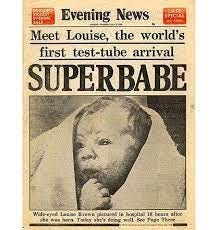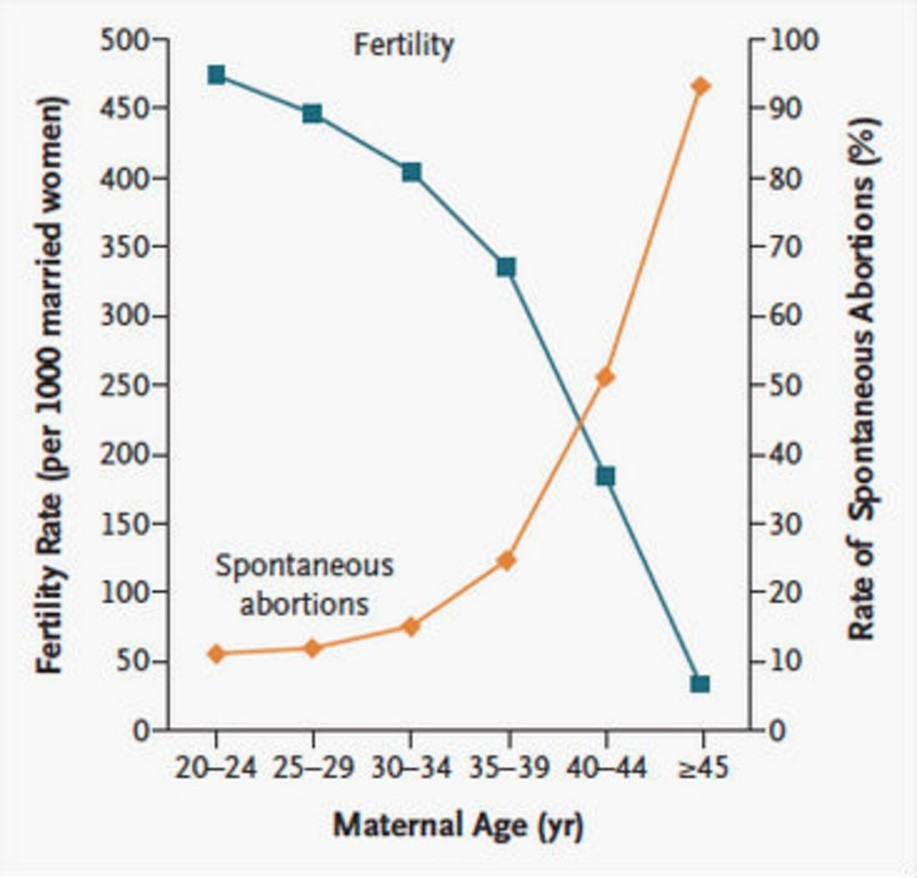Why Seed Oils Matter For Making a Baby
Modern fertility methods pick sperm based on appearance, but this bypasses checks against devastating DNA damage caused by seed oils.
The moment the world met Louise Joy Brown, the first "test-tube baby," on July 25, 1978, marked the dawn of a new era in battling infertility. This medical breakthrough offered hope, bypassing obstacles for many. But the challenge evolved, particularly with growing concerns about male sperm quality. Science responded with even more powerful tools like ICSI. However, this ability to directly select and inject a single sperm – effectively skipping nature's rigorous screening process – brings with it complex considerations about the quality of the genetic material being passed on.
For couples who had endured years of heartache, facing infertility's seemingly insurmountable barrier, In Vitro Fertilisation – IVF – felt nothing short of a miracle. It bypassed blocked fallopian tubes, brought egg and sperm together in the controlled environment of a laboratory dish, and then transferred the resulting embryo back into the womb. It was brilliant. It was revolutionary. It represented a triumph of human ingenuity that unlocked the door to parenthood for millions across the globe.
Yet, even this initial breakthrough possessed limitations. IVF proved remarkably effective when the primary challenge lay with the woman’s anatomy. However, for a significant number of couples, the hurdle resided elsewhere – with the sperm itself. Perhaps the count was too low, or movement was poor (motility, as it is technically known), or their shape irregular. Even within the confines of that lab dish, standard IVF still demanded that sperm possessed a certain fundamental capability – the ability to find and penetrate the egg, effectively participating in a miniature, albeit assisted, race. What recourse was there for those men whose sperm simply couldn't compete, even on that reduced stage?
This specific problem, it became increasingly clear, was not receding. Researchers had alluded to it for years, but recent, large-scale analyses presented a stark, undeniable reality. Male fertility, measured by average sperm count, has been in significant decline globally. Comprehensive studies, such as the meta-analyses led by Hagai Levine, compiling data from disparate parts of the world, revealed average counts plummeting by over 50% between 1973 and 2018. Moreover, the rate of this decline appears to have accelerated since the year 2000. It functioned as a biological alarm signal, a quiet crisis unfolding across generations, meaning the fundamental capability of sperm for that crucial initial 'race' was, for many men, markedly lower than it had been just a few decades prior.
This swift, widespread deterioration in sperm quality and quantity became a powerful impetus for the next significant advance in reproductive technology. That solution arrived later. A refinement. A more direct approach known as Intra-Cytoplasmic Sperm Injection – ICSI.
Consider the profound difference in methodology. With standard IVF, one places sperm and egg together in a dish, hoping nature will take its course. With ICSI, the embryologist, employing incredibly fine instruments, selects a single sperm. Just the one. And injects it directly into the egg's cytoplasm. The race is not merely moved; it is cancelled entirely. Motility issues? Shape problems? A tiny count – even counts so low they would have been deemed unviable years ago? All bypassed. A single sperm, chosen based on visual assessment, is guaranteed entry. It is like awarding the Olympic 100m Gold Medal on the basis of who has the best profile pic.
This marks the critical distinction. ICSI represents the ultimate bypass of nature's intrinsic gatekeeping mechanism for sperm. And like many powerful technological bypasses, particularly one developed in response to a collapsing biological baseline, it compels us to ask. What function did those original gatekeepers serve?
To grasp this, we must consider biology's own timeline. We enjoy longer, healthier lives than previous generations. Forty, we are told, is the new 21. But the biological clock governing reproduction, especially the female clock, adheres to a more ancient rhythm. A woman’s eggs are as old as she is. They reside dormant for decades, accumulating tiny errors, microscopic damage within their DNA. Think of it like static gradually appearing on a very old recording left undisturbed on a shelf. The body, in its wisdom shaped over millennia, possesses inherent responses to this potential for error. It employs filters. It makes conception harder with advancing age. And if a fertilised egg carries significant genetic abnormalities, the body often triggers a miscarriage. Heart-breaking, undoubtedly, but from a biological standpoint, a form of crucial quality control.
For men, while sperm are continuously produced, quality usually declines with age, and as those recent statistics suggest, perhaps due to other contributing factors as well. DNA damage becomes more prevalent. The biological production line begins yielding units with flaws. The body's own checks – the requirements for motility and shape in the natural 'race' – are designed to filter out these less-than-perfect units.
Now, let's throw in a few more elements. Things that act as powerful accelerators to this process of DNA damage, and critically, swamp the body's built-in clean-up and defence systems. We see them in lifestyle choices like smoking and excessive drinking. We also find them in certain components of our modern diet, particularly processed vegetable oils derived from seeds and legumes, often high in omega-6 fats. A key way these seemingly disparate things cause trouble? They all unleash a barrage of nasty chemical compounds known as aldehydes. These aren't passive bystanders; they are fiercely reactive molecules. Think of them as microscopic wrecking balls, slamming into cellular structures and causing significant damage, crucially targeting the delicate DNA within sperm.
The body does possess a sophisticated defence system against aldehydes. A team of enzymes specifically tasked with detoxifying and eliminating them. But here resides the critical point, the absolute nub of the issue. It is largely the same defence team attempting to cope with the cumulative aldehyde load originating from all these sources – smoking, drinking, and seed oils. Imagine that enzyme crew as a limited team grappling with multiple leaks aboard a ship. Each source of exposure – each cigarette, each drink, each meal prepared with unstable oils – adds to their burden. When the volume of leaks becomes too great, the crew is simply swamped. Overwhelmed.
The consequence? The defence system is overwhelmed. Aldehydes and broader oxidative stress proliferate, causing more significant damage to sperm DNA. Smudges appear on the blueprint. More flawed units emerge from the production line. And critically, aldehydes are known to inflict a particularly severe form of damage. Double-strand breaks (DSBs) within the DNA helix. Picture the DNA structure as a ladder. A double-strand break is akin to severing both sides of the ladder simultaneously. This is not a minor imperfection. It represents a break in the fundamental genetic structure, damage that is exceedingly difficult for a cell to repair correctly and carries potentially profound implications for any subsequent life attempting to utilise that blueprint.
Normally, this is precisely where the body’s gatekeepers would intervene. The poor swimmers, the irregularly shaped, many of those carrying DNA damage – especially severe damage like double-strand breaks – would be less likely to navigate the natural selection process within the female reproductive tract. Nature's system, imperfect though it may be, functions as a necessary filter against this kind of fundamental error in the genetic code.
But ICSI? ICSI ducks past those gatekeepers entirely. An embryologist picks a single sperm, mainly based on how it looks and moves. And here is the crucial, deeply unsettling detail. The tech's blind spot that brings us back to those severe aldehyde-induced breaks. Right now, ART clinics simply don't have a reliable test that can spot these specific, double-strand breaks in the DNA of the sperm selected for injection.
Think about what that means. You're choosing a sperm for ICSI that might appear perfectly normal under a microscope. It might be motile. Its count is irrelevant because you only need one. But internally, due to its exposure history – the age, the fags, the drinks, those oils – it could be carrying double-strand breaks caused by aldehydes. A critical flaw in its genetic code. And our current standard tests simply can't see it.
So, when you use ICSI, you are consciously bypassing the very natural filters the body uses to stop sperm with potentially devastating, undetectable DNA damage getting anywhere near the egg. You're selecting a sperm that appears okay, but might be carrying severe internal wreckage that the body would likely have chucked out, precisely because our technology currently lacks the ability to see that specific kind of flaw. When you inject that single, potentially severely damaged, sperm directly into the egg, you circumvent the very system designed to prevent that union.
And what happens then? What are the consequences, potentially stretching across generations, when a sperm carrying a double-strand break succeeds in fertilising an egg? Well, the egg does have its own DNA repair machinery. Think of it as the egg's repair crew, a capable team ready to fix some of the damage the sperm might be bringing. But DSBs are particularly tough customers. They're like a ladder cut clean through both sides. And that repair crew? Its capacity isn't infinite, especially not in an older egg, or one already dealing with its own age-related issues.
If the egg's repair mechanisms fail to fix the double-strand break properly, or if they're overwhelmed by the level of damage, the results can be catastrophic for the developing life. At the earliest stage, it might mean the embryo simply doesn't develop properly, leading to implantation failure or early miscarriage. But if the embryo does continue to develop, unrepaired or misrepaired double-strand breaks can lead to significant errors in the genetic code. This can manifest as mutations, or even large-scale chromosomal rearrangements – bits of chromosomes getting stuck in the wrong place, or sections going missing.
These fundamental errors in the genetic blueprint are the intergenerational consequence. They are passed directly from that damaged sperm to the resulting child. And it's these kinds of genetic and chromosomal abnormalities that are strongly linked to serious health issues observed later in childhood. Things like developmental delays. Certain types of childhood cancers, like leukaemia. Neurodevelopmental conditions such as autism. And even psychiatric conditions that emerge later, like schizophrenia.
The studies we see from places with robust health registries point precisely to increased risks of these very conditions in children conceived via ART, particularly ICSI. These studies reveal a disquieting trend. Compared to naturally conceived children, those born via ART, particularly ICSI, demonstrate increased risks. Significantly higher rates of autism (up to 4.6 times more likely), intellectual disability (2.3 times), childhood leukaemia (a 67% increased risk), and even schizophrenia have been noted. The same patterns appear to be emerging from Western Australia as well. One of the few jurisdictions in Australia with dedicated, high-quality registries. Approximately double the risk of serious birth defects has been reported. These specific health outcomes are precisely the types of severe issues that can be traced back to errors or damage in the foundational genetic blueprint.
This evidence suggests a direct line from the undetectable damage in the sperm, through the bypassed natural filter, past the overwhelmed egg repair system, to a significant health challenge for the next generation. While the most immediate and evident impact is on the health of the child born from that specific conception, these fundamental genetic changes could, in some cases, potentially be passed down further, creating a lineage affected by the initial damage.
All of this possesses a quality of cruel irony. We identify a problem – declining fertility, likely exacerbated by smoking, drinking, and seed oils. These factors contribute to cellular damage, specifically severe DNA damage like undetectable double-strand breaks, and overwhelm natural defences. Our response? We invent brilliant technology to provide a solution. Yet, this solution, by bypassing the body's natural gatekeepers and proceeding without the ability to detect the most severe forms of damage, may inadvertently be creating new challenges for the next generation. We are treating the symptom – the inability to conceive – with technology, potentially sidestepping the underlying cause – damaged cells, overwhelmed defences – and its natural checks. We might be unknowingly injecting a fundamental flaw.
And let’s not overlook the broader context. The sheer scale of the industry involved. ART is a massive enterprise. It represents serious money. Driven by desperate hope, certainly, but also by clear financial incentives – to run cycles, to generate income. This system thrives even though the odds of success per cycle, particularly for older women, are often devastatingly low. It is a system primarily focused on delivering the service, sometimes, perhaps, less inclined to delve into the root causes of infertility or the potential long-term effects of the intervention itself.
So, where does this narrative ultimately lead us? The miracle of IVF remains undeniable. ART does bring profound joy to many lives. But the evolution towards techniques like ICSI, whilst effectively addressing severe male infertility (a problem made more urgent by plummeting sperm counts), also represents a significant departure from natural biological processes. The emerging data suggests this bypass, layered onto factors like age, smoking, drinking, and seed oil-driven oxidative stress and aldehyde production causing undetectable, severe DNA damage, may carry unintended risks for the next generation.
Now, you might ask yourself, has medical advice for men, before they even start trying for a baby, ever mentioned things like smoking or drinking? The answer is yes, it has, but the reasons and the specificity of the message have evolved significantly. Back in the 1960s, with growing awareness of smoking's harms, men were certainly advised not to smoke, but primarily for their own health risks like lung cancer. Advice specifically linking a father's smoking to the quality of his sperm or potential genetic risks for his future child wasn't part of mainstream medical guidance then; that crucial understanding developed much later based on emerging research. It's really only increasingly so in recent times, becoming more common from the late 1990s and solidifying in guidelines throughout the 2000s and 2010s, that health advice began specifically urging prospective fathers to quit smoking and moderate alcohol in the months before conception precisely because of the impact on sperm health and the future child's well-being.
There's a growing awareness that paternal health matters significantly, not just the mother's. Yet, and this is the subtle but important point, the emphasis, the public health campaigns, and the routine nature of the consultation often hasn't matched the intense focus on female preconception health or the vast resources poured into ART. This advice has often been less central, less forcefully communicated, and critically rarely, if ever, mentions the dangers of seed oils in this context.
Perhaps the most crucial conversation extends beyond the technicalities of freezing eggs or selecting an ART clinic. The story, one of overwhelmed biological defences and unseen damage, points towards something more fundamental, something within the realm of individual action. Those aldehydes causing the dangerous double-strand breaks, the ones our advanced technology cannot spot? They largely originate from a few distinct sources. Tobacco smoke. Alcohol consumption. And seed oils.
Minimising exposure to these specific things. Avoiding smoking altogether. Minimising or eliminating alcohol intake. Completely avoiding seed (vegetable) oils. These are not complex medical procedures. They are not dependent on navigating a multi-million dollar industry. They represent tangible actions that owners of sperm can take. Right now. It is about reducing the cumulative load on the body's own defence systems. It is about minimising the silent, severe DNA damage that nature's gatekeepers were designed to filter out, but which ICSI might allow right through. In a world often fixated on complex technological fixes for complex problems, sometimes the most powerful leverage point is surprisingly straightforward. Identify the primary sources of harm. And make a conscious choice to limit or eliminate them from your life. It may not command the headlines of a medical miracle, but it offers a profoundly tangible way to protect the foundational blueprint for the next generation.









